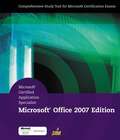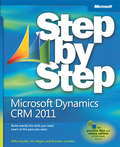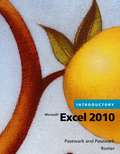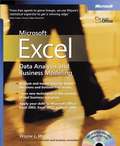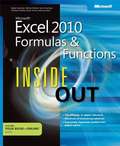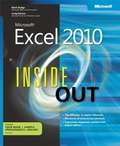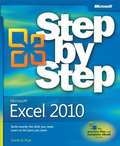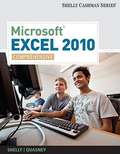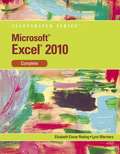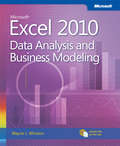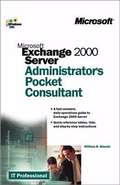- Table View
- List View
Microsoft® Access® 2013: Comprehensive (Shelly Cashman Series)
by Mary Z. Last Philip J. Pratt"Microsoft Access 2013: Comprehensive is intended for a ten- to fifteen-week period in a course that teaches Access 2013 as the primary component. No experience with a computer is assumed, and no mathematics beyond the high school freshman level is required. The objectives of this book are: - To offer a comprehensive presentation of Microsoft Access 2013 - To expose students to practical examples of the computer as a useful tool - To acquaint students with the proper procedures to create databases suitable for coursework, professional purposes, and personal use - To help students discover the underlying functionality of Access 2013 so they can become more productive - To develop an exercise-oriented approach that allows learning by doing. "
Microsoft® Active Directory® Branch Office Guide Volume 1: Planning
by Microsoft CorporationThis guide is aimed at network managers, system integrators, and consultants involved in Active Directory branch office implementations, either in their own organizations or for client companies. By implementing the procedures in this document, you should be able to deploy and maintain Active Directory in a large branch office environment. Deploying Active DirectoryTM directory service in a large branch office environment, in which each branch will have a domain controller locally and branches may be connected to the corporate data center through low-speed links, can be a complicated procedure. This guide intends to simplify this process by providing you with a series of easily understand-able steps that will help you achieve your goal of implementing Active Directory in a branch office environment of 100 or more branches.
Microsoft® Active Directory® Branch Office Guide Volume 2: Deployment and Operations
by Microsoft CorporationThis guide is aimed at network managers, system integrators, and consultants involved in Active Directory branch office implementations, either in their own organizations or for client companies. By implementing the procedures in this document, you should be able to deploy and maintain Active Directory in a large branch office environment. Deploying Active DirectoryTM directory service in a large branch office environment, in which each branch will have a domain controller locally and branches may be connected to the corporate data center through low-speed links, can be a complicated procedure. This guide intends to simplify this process by providing you with a series of easily understand-able steps that will help you achieve your goal of implementing Active Directory in a branch office environment of 100 or more branches.
Microsoft® Application Architecture Guide
by Microsoft Patterns Practices TeamGet the definitive guide on designing applications on the Microsoft application platform--straight from the Microsoft patterns & practices team. Learn how to choose the most appropriate architecture and the best implementation technologies that the Microsoft application platform offers applications developers. Get critical design recommendations and guidelines organized by application type--from Web, mobile, and rich Internet applications to Office Business Applications. You'll also get links to additional technical resources that can help with your application development.
Microsoft® CLR via C#, Second Edition
by Jeffrey Richter<div xmlns="http://www.w3.org/1999/xhtml"><p>Your hands-on guide to developing applications with the common language runtime (CLR) and Microsoft .NET Framework 2.0, with examples in Microsoft Visual C# 2005.</p></div>
Microsoft® Certified Application Specialist Study Guide: 2007 Microsoft Office System Edition
by Otsi<div xmlns="http://www.w3.org/1999/xhtml"><p>Get in-depth, all-in-one prep for the Microsoft Certified Application Specialist exams. Work through the tutorials and practice questions\u2014demonstrating your expertise in Microsoft Word 2007, Excel\xae 2007, Outlook\xae 2007, PowerPoint\xae 2007, and Access\xae 2007.</p></div>
Microsoft® Certified Application Specialist: Microsoft® Office 2007 Edition
by Pam Conrad Jennifer T. Campbell Barbara Clemens Lisa Ruffolo Rachel Biheller BuninNIMAC-sourced textbook
Microsoft® Dynamics® CRM 2011 Step by Step
by Mike Snyder Jim Steger Brendan LandersThe smart way to learn Microsoft Dynamics CRM 2011--one step at a time! Use the easy-to-follow lessons to master the fundamentals of creating and managing accounts; working directly within familiar tools such as Microsoft Outlook®; tracking customer activity and communications; managing campaigns, leads, quotes, contracts, and orders; and employing basic to advanced reporting capabilities. Includes downloadable, ready-made practice files and complete Book.
Microsoft® Excel 2010, Introductory
by Beth Pasewark Wadsworth Carolyn Denny Pasewark Jan Pasewark Stogner Scott G. Pasewark William R. Pasewark Robin M. RomerMicrosoft Excel 2010 Introductory, part of the Origins Series, is designed for beginning users of Microsoft Office 2010. This self-paced, step-by-step book with corresponding screenshots makes learning easy and enjoyable. Students will learn the new features of excel through a variety of activities, simulations, and case studies. End-of-lesson exercises reinforce the skills covered in each lesson.
Microsoft® Excel Data Analysis and Business Modeling
by Wayne L. WinstonMaster the techniques that business analysts at leading companies use to transform data into bottom-line results. For more than a decade, well-known consultant and business professor Wayne Winston has been teaching corporate clients and MBA students the most effective ways to use Microsoft Excel for data analysis, modeling, and decision making. Now this award-winning educator shares the best of his classroom experience in this practical, business-focused guide. Each chapter advances your data analysis and modeling expertise using real-world examples and learn-by-doing exercises. You also get all the book's problem-and-solution files on CD--for all the practice you need to solve complex problems and work smarter with Excel. Learn how to solve real business problems with Excel! Create best, worst, and most-likely scenarios for sales Calculate how long it would take to recoup a project's startup costs Plan personal finances, such as computing loan terms or saving for retirement Estimate a product's demand curve Simulate stock performance over a year Determine which product mix will yield the greatest profits Interpret the effects of price and advertising on sales Assign a dollar value to customer loyalty Manage inventory and order quantities with precision Create customer service queues with short wait times Estimate the probabilities of equipment failure Model business uncertainties Get new perspectives on data with PivotTable dynamic views Help predict quarterly revenue, outcomes of sporting events, presidential elections, and more! On the CD: Practice files for all the book's exercises Solutions for problem sets Fully searchable eBook A Note Regarding the CD or DVD The print version of this book ships with a CD or DVD. For those customers purchasing one of the digital formats in which this book is available, we are pleased to offer the CD/DVD content as a free download via O'Reilly Media's Digital Distribution services. To download this content, please visit O'Reilly's web site, search for the title of this book to find its catalog page, and click on the link below the cover image (Examples, Companion Content, or Practice Files). Note that while we provide as much of the media content as we are able via free download, we are sometimes limited by licensing restrictions. Please direct any questions or concerns to booktech@oreilly.com.
Microsoft® Excel Data Analysis and Business Modeling
by Wayne WinstonNow you can apply the techniques that business analysts at leading companies use to analyze and transform data into bottom line results. For more than 10 years, well- known consultant and business professor Wayne Winston has been teaching corporate clients and MBA candidates the most effective ways to use Microsoft Excel for data analysis, modeling, and decision making. This practical, business-focused guide delivers the best of Winston's classroom experience to you-from asset allocation modeling to estimating exponential growth, forecasting sales, optimizing portfolios, and other critical functions. You also get all the book's sample files on CD-ROM - ready for use in your own work.
Microsoft® Excel® & AccessTM Integration with Office 2007
by Michael Alexander Geoffrey ClarkAlthough many people rarely go from Excel into Access or vice versa, you should know that Microsoft actually designed these applications to work together. In this book, you'll discover how Access benefits from Excel's flexible presentation layer and versatile analysis capabilities, while Access's relational database structure and robust querying tools enhance Excel. Once you learn to make the two work together, you'll find that your team's productivity is the real winner.
Microsoft® Excel® 2010 Formulas and Functions Inside Out
by Egbert Jeschke Helmut Reinke Sara Unverhau Eckehard Pfeifer Bodo Fienitz Jens BockConquer Microsoft® Excel® formulas and functions--from the inside out! You're beyond the basics, so dive right in and really put Excel formulas and functions to work! This supremely organized reference packs hundreds of timesaving solutions, troubleshooting tips, and workarounds. It's all muscle and no fluff. Discover how the experts increase their data analysis capabilities using Excel 2003, 2007, or 2010--and challenge yourself to new levels of mastery. Customize Excel formulas using 350+ built-in functions Create reusable formulas for common calculations Learn smarter ways to calculate date and time values Systematically search worksheets with lookup and reference functions Perform advanced calculations using mathematical, statistical, and financial functions Build complex formulas by nesting one function inside of another Analyze profit margins and more with new functions in Excel 2010 Develop your own functions with Visual Basic® for Applications (VBA)
Microsoft® Excel® 2010 Inside Out
by Craig Stinson Mark DodgeYou're beyond the basics, so dive in and really put your spreadsheet skills to work! This supremely organized reference is packed with hundreds of timesaving solutions, troubleshooting tips, and workarounds. It's all muscle and no fluff. Discover how the experts tackle Excel 2010-and challenge yourself to new levels of mastery!Learn expert techniques for designing powerful spreadsheets Apply built-in functions-or write your own-and carry out complex calculations Use rich charting and graphic capabilities to visualize data Perform sophisticated data analysis: financial, statistical, and "what-if" Design PivotTable reports to dynamically analyze data Share and collaborate with others-while managing sensitive data Link and embed Excel data into other documents Create macros with Microsoft Visual Basic® for Applications Sample spreadsheets from inside the book Add-ins and other resources to help you extend Microsoft Office programs Links to demos, user communities, and product support
Microsoft® Excel® 2010 Step by Step
by Curtis D. FryeExperience learning made easy-and quickly teach yourself how to organize, analyze, and present data with Excel 2010. With STEP BY STEP, you set the pace-building and practicing the skills you need, just when you need them! Topics include creating formulas, calculating values, and analyzing data; presenting information visually with graphics, charts, and diagrams; building PivotTable dynamic views; using the new Excel Web App; reusing information from databases and other documents; creating macros to automate repetitive tasks and simplify your work; and other core topics.
Microsoft® Excel® 2010, Comprehensive
by Gary B. Shelly Steven M. Freund Jeffrey J. Quasney Raymond E. Enger Mali B. JonesMicrosoft Office Excel 2010: Comprehensive provides a project-based, step-by-step approach to successfully teach students Microsoft Excel 2010 skills.
Microsoft® Excel® 2010, Illustrated, Complete
by Elizabeth Eisner Reding Lynn WermersLoved by instructors for its visual and flexible way to build computer skills, the Illustrated Series is ideal for teaching MICROSOFT OFFICE EXCEL 2010 to both computer rookies and hotshots. Each two-page spread focuses on a single skill, making information easy to follow and absorb. Large, full-color illustrations represent how the students' screen should look. Concise text introduces the basic principles of the lesson and integrates a case study for further application.
Microsoft® Excel® 2010: Data Analysis and Business Modeling
by Wayne L. WinstonMaster the business modeling and analysis techniques that help you transform data into bottom-line results. For more than a decade, Wayne Winston has been teaching corporate clients and MBA students the most effective ways to use Excel to solve business problems and make better decisions. Now this award-winning educator shares the best of his expertise in this hands-on, scenario-focused guide--fully updated for Excel 2010! Use Excel to solve real business problems--and sharpen your edge! Model investment risks and returns Analyze your sales team's effectiveness Create best, worst, and most-likely case scenarios Compare lease vs. buy, and calculate loan terms See how price, advertising, and seasonality affect sales Manage inventory with precision Quantify the value of customer loyalty Calculate your break-even number and ROI Maximize scheduling efficiency Express "home-field advantage" in real numbers Project company growth, predict election results, and more! Plus--introduce yourself to PowerPivot for Excel Your companion web content includes: Downloadable eBook Hundreds of scenario-based practice problems All the book's sample files--plus customizable templates Customer Service Note: We are sorry for the inconvenience, but the code for accessing the eBook version of this title was accidentally left out of the first printing. However, the code is available for buyers of the first printing by contacting O'Reilly Media, the official distributor for Microsoft Press books, at mspbooksupport@oreilly.com or 800-889-8969. All subsequent printings include the access code and instructions inside the book.
Microsoft® Excel® 2013 Plain & Simple
by Curtis D. FryeGet the guide that makes learning Microsoft Excel plain and simple! This full color, no-nonsense book shows you the quickest ways to solve a problem or learn a skill, using easy-to-follow steps and concise, straightforward language. You'll analyze, manage, and share information in more ways than ever before. Here's WHAT you'll learn: Manage your financial data and personal expenses Get started quickly with prebuilt templates Create formulas and functions to do the hard work Sort, filter, update, and copy your data Use charts and graphics to bring data to life Collaborate with colleagues by sharing spreadsheets online Here's HOW you'll learn it: Jump in whenever you need answers Easy-to-follow STEPS and SCREENSHOTS show exactly what to do Handy TIPS teach new techniques and shortcuts Quick TRY THIS! exercises help apply what you learn right away
Microsoft® Excel® 2013: Building Data Models with PowerPivot
by Marco Russo Alberto FerrariYour guide to quickly turn data into results. Transform your skills, data, and business--and create your own BI solutions using software you already know and love: Microsoft Excel. Two business intelligence (BI) experts take you inside PowerPivot functionality for Excel® 2013, with a focus on real world scenarios, problem-solving, and data modeling. You'll learn how to quickly turn mass quantities of data into meaningful information and on-the-job results--no programming required! Understand the differences between PowerPivot for Self Service BI and SQL Server Analysis Services for Corporate BI Extend your existing data-analysis skills to create your own BI solutions Quickly manipulate large data sets, often in millions of rows Perform simple-to-sophisticated calculations and what-if analysis Create complex reporting systems with data modeling and Data Analysis Expressions Share your results effortlessly across your organization using Microsoft SharePoint®
Microsoft® Excel® 2016 Workbook (Marquee Series)
by Nita Rutkosky Ian Rutkosky Audrey RoggenkampMarquee Series: Microsoft Excel 2016 offers a highly visual, hands-on approach to learning Microsoft Excel. Ideal for 1 or 2 credit courses, this text facilitates self-paced, accelerated, and traditional learning formats.
Microsoft® Excel® 2016: Comprehensive (Shelly Cashman)
by Joy L. Starks Steven M. Freund Eric J. SchmiederIntroduce your students to the latest advancements that Microsoft® Office and Excel 2016 have to offer with MICROSOFT® OFFICE 365 & EXCEL 2016: COMPREHENSIVE -- the new edition in the acclaimed Shelly Cashman Series®. For more than three decades, the Shelly Cashman Series® has effectively introduced computer skills to millions. MICROSOFT® OFFICE 365 & EXCEL 2016: COMPREHENSIVE continues the Series’ strong history of innovation with a hallmark learning approach now enhanced to address the varied learning styles of today’s students. A trademark, step-by-step, screen-by-screen approach provides a thorough understanding of Microsoft® Excel 2016 through experimentation, critical thought, and personalization. This new edition and accompanying resources deliver effective educational materials specifically designed to engage readers, improve retention, and prepare students for future success in working with all aspects of Excel 2016.
Microsoft® Exchange 2000 Server Administrator's Pocket Consultant
by William R. StanekMICROSOFT® EXCHANGE 2000 SERVER ADMINISTRATOR'S POCKET CONSULTANT is the concise, easy-to-use reference you'll want with you at all times as you support and manage Microsoft Exchange 2000 Server and Exchange 2000 Enterprise Server. Ideal at the desk or on the go from server to workstation, this hands-on, fast-answers guide focuses on what you need to do to get the job done. With extensive easy-to-read tables, lists, and step-by-step instructions, it's the portable, readable guide that will consistently save you time and effort. This hands-on guide provides fast answers to help you: Complete fundamental tasks--use administrative tools, understand integration with Windows 2000, manage and troubleshoot mail clients such as Microsoft Outlook® 2000 and Outlook Express, and configure and manage user access privileges Work with Active DirectoryTM services (ADS)--take advantage of powerful new directory services to centrally manage administration and security functions, simplify managing a large installation, and reduce your workload Administer and troubleshoot data storage--efficiently manage data and storage groups, manage public folders and Web stores, reliably back up and recover Exchange data, and import and export Exchange data Administer servers and groups--manage organizations and messaging connectors, use administration and routing groups, administer virtual servers and routing protocols, maintain and replicate the directory, and monitor Exchange 2000 Server
Microsoft® Exchange 2000 Server Hosting Series Volume 2: Deployment
by Microsoft CorporationThe Exchange 2000 Server Hosting series was created to help network managers, system integrators, and consultants involved in planning and deploying hosted Exchange 2000 implementations. This volume, Deployment, builds on that information and includes the step-by-step procedures required to implement this design. The companion volume, Planning, describes the tasks and decisions that must be completed to develop a framework suitable for hosting a large number of customers and users in a shared forest environment. While this guide is primarily focused on the Application Service Provider hosting their customers' messaging infrastructures, the issues and concepts discussed here can be used by any organization to provide access to the full range of Exchange 2000 Server facilities across a public network. This book covers the following topics: Configuring routers and switches Implementing Active Directory for hosting Installing the back-end servers Deploying ISA server Installing the front-end servers Implementing Domain Name Service for hosting Adding organizations and users The companion CD-Rom contains scripts and executable code. To run the scripts included on this CD, you will need Microsoft Internet Security and Acceleration Server 2000. Book Content: Introduction Configuring routers & switches Implementing active directory for hosting Installing the back-end servers Deploying ISA Server Installing the front-end servers Implementing domain name service for hosting Adding organizations & users CD contains group policy templates A Note Regarding the CD or DVDThe print version of this book ships with a CD or DVD. For those customers purchasing one of the digital formats in which this book is available, we are pleased to offer the CD/DVD content as a free download via O'Reilly Media's Digital Distribution services. To download this content, please visit O'Reilly's web site, search for the title of this book to find its catalog page, and click on the link below the cover image (Examples, Companion Content, or Practice Files). Note that while we provide as much of the media content as we are able via free download, we are sometimes limited by licensing restrictions. Please direct any questions or concerns to booktech@oreilly.com.
Microsoft® Exchange 2000 Server Operations Guide
by Microsoft CorporationMicrosoft Exchange 2000 Server Operations is designed to provide the best information on how to manage Exchange in a day-to-day environment. An operations team needs to perform a wide variety of procedures, including server monitoring, backup, verification of scheduled events, protection against attack, and user support. This guide includes instructions for those procedures along with steps for dealing with unresolved issues in a timely manner. Exchange 2000 Server Operations draws from the knowledge and best practice guidelines from Microsoft Consulting Services (MCS), Microsoft's Internal Technical Support Group, and the Exchange Development Team.





